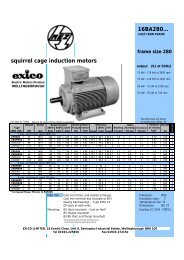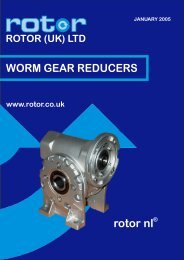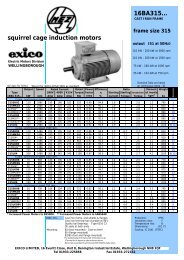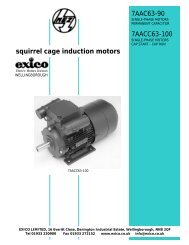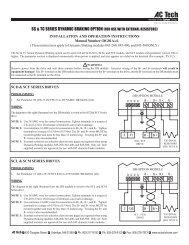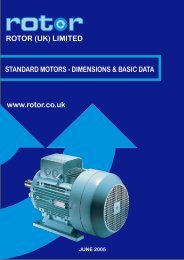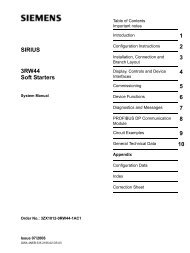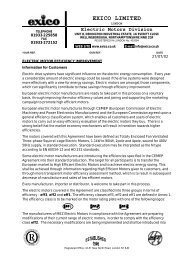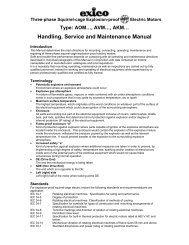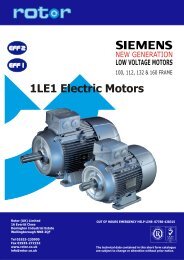Worm Gear Reducers (MRT) - Rotor UK
Worm Gear Reducers (MRT) - Rotor UK
Worm Gear Reducers (MRT) - Rotor UK
Create successful ePaper yourself
Turn your PDF publications into a flip-book with our unique Google optimized e-Paper software.
15. WORM GEAR PARAMETERS & REVERSIBILITY / SELF-LOCKING PROPERTIES<br />
Table 15.1 <strong>Worm</strong> Parameters<br />
<strong>MRT</strong> 5 7.5 10 12.5 15 20 25 30 40 50 60 70 80 100<br />
m n<br />
1.30 1.35 1.40 1.10 1.35 1.10 1.66 1.40 1.02 0.85 0.72 0.62 0.55 0.45<br />
30A γ 25˚23´ 18˚ 4´ 13˚21´ 10˚17´ 8˚51´ 7˚37´ 5˚13´ 4˚31´ 3˚ 6´ 2˚48´ 2˚29´ 2˚ 9´ 1˚59´ 1˚44´<br />
Z 1<br />
6 4 3 3 2 2 1 1 1 1 1 1 1 1<br />
m n<br />
2.00 1.84 2.00 1.62 2.06 1.62 1.25 2.06 1.62 1.25 1.10 0.95 0.80 0.65<br />
40A γ 30˚0´ 27˚43´ 18˚43´ 15˚59´ 12˚42´ 12˚17´ 9˚26´ 6˚41´ 6˚18´ 4˚13´ 4˚38´ 4˚ 6´ 2˚52´ 2˚33´<br />
Z 1<br />
5 4 3 3 2 2 2 1 1 1 1 1 1 1<br />
m n<br />
2.15 2.25 2.55 2.00 2.50 2.00 1.55 2.55 2.00 1.60 1.36 1.15 1.02 0.82<br />
50A γ 37˚45´ 21˚19´ 20˚55´ 17˚27´ 13˚56´ 12˚ 9´ 9˚12´ 6˚23´ 5˚53´ 4˚46´ 4˚18´ 3˚27´ 3˚13´ 2˚38´<br />
Z 1<br />
6 4 3 3 2 2 2 1 1 1 1 1 1 1<br />
m n<br />
3.00 2.75 3.00 2.43 3.125 2.43 1.97 3.125 2.43 1.97 1.65 1.43 1.25 1.00<br />
60A γ 30˚20´ 25˚28´ 19˚28´ 19˚ 2´ 13˚37´ 12˚25´ 10˚23´ 7˚ 6´ 6˚14´ 5˚23´ 4˚35´ 4˚11´ 3˚41´ 2˚56´<br />
Z 1<br />
5 4 3 3 2 2 2 1 1 1 1 1 1 1<br />
m n<br />
3.50 3.20 3.50 2.80 3.60 2.80 2.25 3.60 2.75 2.25 1.85 1.60 1.40 1.15<br />
70A γ 32˚31´ 25˚11´ 19˚49´ 16˚56´ 12˚50´ 11˚21´ 9˚21´ 6˚36´ 5˚28´ 4˚46´ 3˚45´ 3˚20´ 2˚56´ 2˚40´<br />
Z 1<br />
5 4 3 3 2 2 2 1 1 1 1 1 1 1<br />
m n<br />
4.00 3.65 4.00 3.20 4.00 3.20 2.58 4.00 3.20 2.58 2.20 1.85 1.65 1.35<br />
80A γ 30˚ 0´ 24˚54´ 18˚37´ 17˚27´ 11˚12´ 11˚32´ 9˚21´ 5˚55´ 5˚59´ 4˚51´ 4˚35´ 3˚31´ 3˚26´ 3˚ 6´<br />
Z 1<br />
5 4 3 3 2 2 2 1 1 1 1 1 1 1<br />
m n<br />
- 4.50 4.50 4.00 5.00 3.75 3.00 5.00 3.75 3.00 2.50 2.25 2.00 1.50<br />
100A γ - 17˚55´ 13˚20´ 17˚15´ 12˚ 1´ 8˚59´ 7˚ 6´ 5˚59´ 4˚29´ 3˚33´ 2˚54´ 3˚4´ 2˚54´ 1˚44´<br />
Z 1<br />
- 4 3 3 2 2 2 1 1 1 1 1 1 1<br />
m n<br />
- 5.50 6.00 5.00 6.00 4.50 3.75 6.00 4.50 3.75 3.00 2.75 2.50 2.00<br />
120A γ - 20˚44´ 19˚28´ 19˚28´ 12˚50´ 8˚56´ 8˚18´ 6˚23´ 4˚27´ 4˚ 8´ 2˚53´ 3˚22´ 3˚38´ 2˚54´<br />
Z 1<br />
- 4 3 3 2 2 2 1 1 1 1 1 1 1<br />
m n<br />
- 7.0 7.0 6.0 7.5 6.0 4.5 8.0 6.0 5.0 4.0 3.5 3.0 2.5<br />
150A γ - 23˚34´ 15˚37´ 15˚ 7´ 13˚ 8´ 13˚ 5´ 7˚ 8´ 8˚ 0´ 5˚56´ 5˚59´ 3˚53´ 3˚42´ 2˚53´ 2˚54´<br />
Z 1<br />
- 4 3 3 2 2 2 1 1 1 1 1 1 1<br />
m n<br />
- 8.0 8.0 7.0 8.0 7.0 5.5 9.0 7.0 5.5 4.5 4.0 3.5 3.0<br />
180A γ - 17˚55´ 13˚20´ 12˚22´ 8˚49´ 10˚46´ 7˚39´ 5˚51´ 5˚ 7´ 3˚44´ 2˚53´ 2˚54´ 2˚32´ 2˚46´<br />
Z 1<br />
- 4 3 3 2 2 2 1 1 1 1 1 1 1<br />
Legend: m n<br />
– gear module, γ – helix angle (for γ > 23˚ left helix is used for technological reasons), Z 1<br />
– number of flights<br />
Self-locking Properties<br />
A worm gearing is self-locking if it is not possible to turn the input shaft by<br />
turning of the output shaft. The worm gearing is self-locking if the worm<br />
helix angle is lower than the friction angle at idle or when the static efficiency<br />
of the gearing is lower than 50 %. The gearing is then statically<br />
self-locking. Should the worm helix angle be lower than dynamic friction<br />
angle or when the dynamic efficiency of the gearing is lower than 50 %,<br />
the gearing is dynamically self-locking.<br />
The following relation applies:<br />
η= tgγ / tg(γ+ϕ) or η = tgγ / tg(γ+ arctg (µz)<br />
η efficiency ϕ friction angle (ϕ = arctg (µ z<br />
))<br />
γ worm helix angle µ z<br />
coefficient of friction in gearing<br />
Static coefficient of friction between gear materials (steel – bronze) is within<br />
the range of µ z<br />
= 0.09 to 0.14 depending on the lubricant used (its age,<br />
conditions and temperature) and the roughness of contact surfaces (given<br />
by gearing wear). The conforming friction angle is ϕ s<br />
= 5˚ to 8˚.<br />
When static self-locking property can be influenced by vibrations or shocks<br />
a dynamic coefficient of friction shall be considered. The value of the<br />
dynamic coefficient of friction depends on surface roughness, the lubricant<br />
used, the load applied and the sliding speed. It ranges within µ z<br />
= 0.02<br />
and 0.05 for standard load and speed 900 to 1400 rpm. The conforming<br />
dynamic friction angle is ϕd = 1˚ to 3˚.<br />
With respect to the fact that the helix angles are higher than 1.5˚ at all<br />
gear ratios, the 100% self-locking cannot be guaranteed. In cases when<br />
the gear unit must be secured against slipping, it is recommended to use<br />
electric motors with brakes.<br />
Table 15.2 Self-locking Status<br />
γ Self-locking<br />
> 25˚ total reversibility<br />
static reversibility<br />
12˚ – 25˚ reversing rapidly<br />
dynamic reversibility<br />
variable and static reversibility<br />
8˚ – 12˚ reversing rapidly when vibrating<br />
dynamic reversibility<br />
static self-locking<br />
5˚ – 8˚ reversing when vibrating<br />
light dynamic self-locking<br />
static self-locking<br />
reversing slowly when vibrating<br />
3˚ – 5˚<br />
almost dynamically self-locking<br />
light dynamic reversibility when vibrating<br />
static self-locking<br />
1˚ – 3˚ dynamic self-locking<br />
light dynamic reversibility when vibrating<br />




